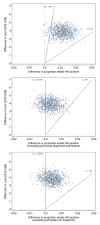Pragmatic economic evaluation of community-led delivery of HIV self-testing in Malawi
- PMID: 34275869
- PMCID: PMC8287609
- DOI: 10.1136/bmjgh-2020-004593
Pragmatic economic evaluation of community-led delivery of HIV self-testing in Malawi
Abstract
Introduction: Community-based strategies can extend coverage of HIV testing and diagnose HIV at earlier stages of infection but can be costly to implement. We evaluated the costs and effects of community-led delivery of HIV self-testing (HIVST) in Mangochi District, Malawi.
Methods: This economic evaluation was based within a pragmatic cluster-randomised trial of 30 group village heads and their catchment areas comparing the community-led HIVST intervention in addition to the standard of care (SOC) versus the SOC alone. The intervention involved mobilising community health groups to lead 7-day HIVST campaigns including distribution of HIVST kits. The SOC included facility-based HIV testing services. Primary costings estimated economic costs of the intervention and SOC from the provider perspective, with costs annualised and measured in 2018 US$. A postintervention survey captured individual-level data on HIV testing events, which were combined with unit costs from primary costings, and outcomes. The incremental cost per person tested HIV-positive and associated uncertainty were estimated.
Results: Overall, the community-led HIVST intervention costed $138 624 or $5.70 per HIVST kit distributed, with test kits and personnel the main contributing costs. The SOC costed $263 400 or $4.57 per person tested. Individual-level provider costs were higher in the community-led HIVST arm than the SOC arm (adjusted mean difference $3.77, 95% CI $2.44 to $5.10; p<0.001), while the intervention effect on HIV positivity varied based on adjustment for previous diagnosis. The incremental cost per person tested HIV positive was $324 but increased to $1312 and $985 when adjusting for previously diagnosed self-testers or self-testers on treatment, respectively. Community-led HIVST demonstrated low probability of being cost-effective against plausible willingness-to-pay values, with HIV positivity a key determinant.
Conclusion: Community-led HIVST can provide HIV testing at a low additional unit cost. However, adding community-led HIVST to the SOC was not likely to be cost-effective, especially in contexts with low prevalence of undiagnosed HIV.
Trial registration number: NCT03541382.
Keywords: HIV; cluster randomized trial; health economics; other diagnostic or tool.
©World Health Organization 2021. Licensee BMJ.
Conflict of interest statement
Competing interests: None declared.
Figures



References
-
- UNAIDS . UNAIDS data 2019. Geneva, Switzerland: Joint United Nations Programme on HIV/AIDS (UNAIDS); 2019.
-
- Ministry of Health [Malawi] . Malawi population-based HIV impact assessment (MPHIA) 2015-2016: final report. Lilongwe: Ministry of Health; 2018.
Publication types
MeSH terms
Associated data
Grants and funding
LinkOut - more resources
Full Text Sources
Medical
